Out on a Limb - the road through Tunduru: German East Africa, May to November 1917
- Home
- World War I Articles
- Out on a Limb - the road through Tunduru: German East Africa, May to November 1917
In May 1917 the 1st Battalion of the Uganda-based 4th Regiment of the King's African Rifles (1/4 KAR) was in Fort Johnstone, Nyasaland (now Malawi). The battalion had marched down through German East Africa (GEA - now Tanzania) from Mwanza on Lake Victoria via Iringa to Old Langenburg, now named Lumbira, on Lake Nyasa. 1/4 KAR had fought and skirmished against the withdrawing Schutztruppe (German army) as it marched. The battalion had then travelled by steamer down Lake Nyasa to Fort Johnston.
The 4th Regiment of The King's African Rifles had recently been expanded into three battalions, and the 1st Battalion had transferred half of its experienced Askari into the 2nd Battalion, absorbing new recruits as replacements. Lieutenant Colonel W T Shorthose (South Staffordshire Regiment) commanded.
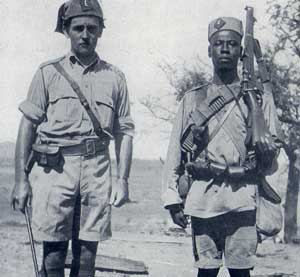
Major H S Pinder (Leicestershire Regiment) was the Second in Command, and Captain E A G Snell (Bedfordshire Regiment) was the Adjutant. Numbers 1 and 3 Rifle Companies contained Sudanese Askari recruited from the White Nile region, No 2 Company was recruited mainly from the Kavirondo and Teso tribes of Uganda, and No 4 Company was composed of Bagandans also from Uganda.
The Mtonia Mobile Column
The German commander in East Africa, Colonel Paul von Lettow-Vorbeck, was an astute and experienced African campaigner who always coordinated his logistical requirements with his military operations; thus the Schutztruppe rarely ran out of supplies whilst, unfortunately, the British forces more than often did. Von Lettow instituted crop-growing in safe areas of GEA in order to feed his soldiers, and in the Spring of 1917 he despatched troops under Major Willibald von Stuemer into Portuguese East Africa (PEA - now Mozambique) to collect crops from areas south of the Rovuma River. British recruiting parties from Nyasaland were also operating in PEA and a contact occurred with the Germans near the Nyasaland border.
As it appeared that Nyasaland was being threatened from PEA, the British commander in the region, Brigadier General Sir Edward Northey, ordered 1/4 KAR to advance from Mtonia to Mwembe in PEA.
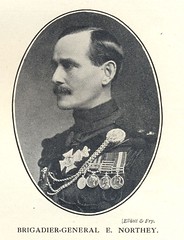
Colonel Shorthose had in his battalion 642 Askari and 35 British officers and senior Non-Commissioned Officers plus eight machine guns; he was supported by two machine guns from the 5th South African Infantry under Lieutenant M Clarke, and a section of two mountain guns manned by the South African Mounted Rifles. These guns had been captured in German South West Africa and they could be dismantled for carrying by mules and porters. The Mtonia Mobile Column as it was named marched out on 29 June 1917.
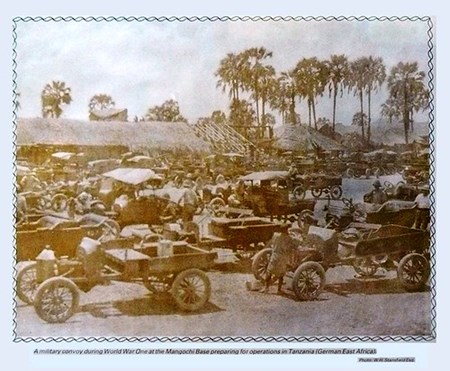
On 4 July near Sefu in PEA a contact occurred when an enemy group of three Europeans and around 25 Askari was bumped. After an exchange of fire the enemy got away but a German naval officer named Captain Gustaf Zimmer left behind some documents containing useful information. During the previous day whilst crossing the Luachesi River 3554 Sergeant Bilal Mahabout of No 1 Company had saved another man from drowning. For this courageous act Sergeant Bilal later received a Meritorious Service Medal.
No 2 Company was the Advance Guard on 5 July when a German field company was encountered at noon on a rocky hillock a few kilometres before Mwembe. A sharp fight took place over three hours before the enemy withdrew, the rocky ground hindering rapid deployment by the KAR Askari. For gallantry displayed in attacking an enemy outpost, during which he was wounded twice, Temporary Major Harold Senhouse Pinder was awarded a Military Cross. Three Askari were also wounded. During the following day Mwembe was occupied without opposition and the column commenced dominating the area with patrols and outposts. Regular re-supply convoys of porters began to arrive from Nyasaland.
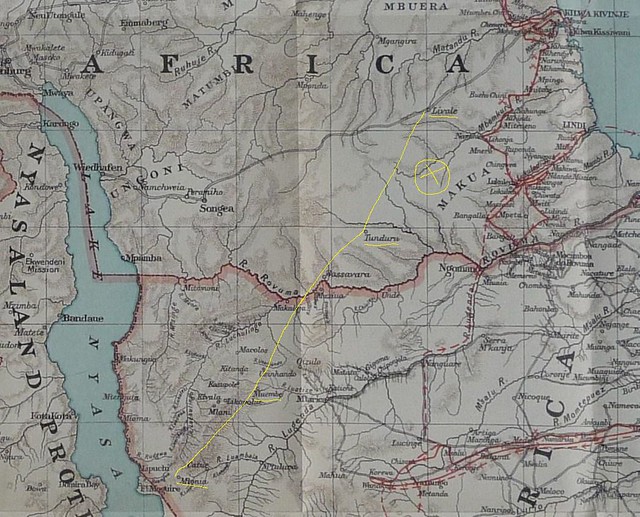
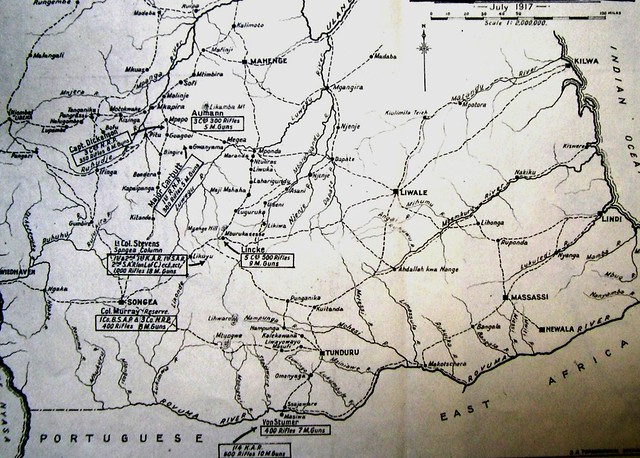
The march on Tunduru, GEA
On 10 July the British BE2c aeroplane operating out of Nyasaland, known as the ‘Old Bee', made a precarious landing at Mwembe Boma.
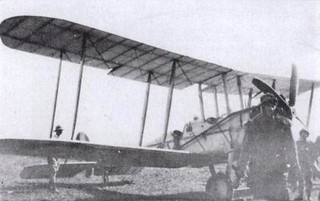
The pilot was Captain Gerard William Hodgkinson MC (Royal Flying Corps, Yeomanry and East African Mounted Rifles) and his observer was Lieutenant Leo Walmsley MC (Royal Flying Corps and East Yorkshire Regiment) who later became a successful author. Hodgkinson handed Shorthose a written order from headquarters stating: "You will march on Tunduru and occupy it as soon as possible. You must live on the country as no other convoy can be sent after you". Tunduru was around 200 kilometres north-east of Mwembe and was located in GEA two days' march beyond the Rovuma River. As the Schutztruppe withdrew into the south-east of GEA General Northey wished to deny Tunduru to the enemy. Shorthose concentrated his men, now named the Mwembe Flying Column, and had them moving three days later, leaving the mountain guns at Mwembe with a dozen men from the 5th South African Infantry. The ‘Old Bee' evacuated Harold Pinder and Major E B B Hawkins (West Yorkshire Regiment) was appointed to be Second in Command of the battalion; at that time Major Hawkins was in Dar Es Salaam with a party of reinforcements but he caught up with the battalion in late August.
After brief skirmishes on the route the Rovuma River was reached on 29 July; this was the border between PEA and GEA. Shorthose marched his men upstream for 12 kilometres before a suitable crossing place was found, then a few bold Askari swam across with ropes whilst rafts were constructed from tents filled with grass. By noon the next day the column was across the river with only one mule lost in the water. In recognition of this fine piece of work the Column Transport Officer, Lieutenant J A Kelly, (Royal Inniskilling Fusiliers), received a Military Cross. Two Askari of No 3 Company, Lieutenant 3715 Aboukir Effendi Ahmed and 5802 Private Cjerogwe Atwol received the Meritorious Service Medal; perhaps they had been active as swimmers during the crossing.
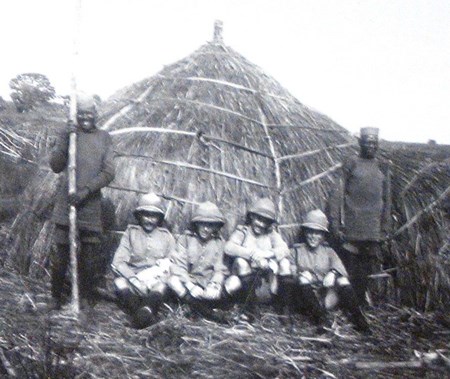
The column, now named Shorthose Column, marched through Bibi Mtaka towards Tunduru. At first light on 4 August, a patrol under Sergeant Hollander advanced down the Tunduru road near Lipepo and drew fire from an enemy position on a ridge. A serious action then developed during which the Intelligence Officer, Lieutenant C Walser, went forward until he was out of sight. The Germans were using two machine guns so Shorthose sent forward reinforcements and ordered the Advance Guard commander to quickly resolve the situation, which he did as the enemy withdrew upon receiving British machine gun fire.
The award of the Military Cross was made to Lieutenant William Mackay Sparke (4th Royal Scots, Territorial Force):
For conspicuous gallantry and devotion to duty. He most gallantly remained alone at a distance of thirty yards from an enemy machine gun, firing at the gunners whenever opportunity occurred. He remained in this position, compelling the enemy gunners to keep their heads down until they were driven out by our own machine-gun fire. He has at all times displayed great gallantry, initiative, and fine leadership.
When the column advanced a shallow grave was found in which was buried the body of Cyrus Walser, who had been shot through the head by machine gun fire. This was a bad loss for the Column as Cyrus could speak and read German (he had changed his name from Walsen), and he was adept at obtaining information from villagers. One Askari was also killed and eight were wounded. For bravery displayed when under enemy fire C M 24 Sergeant B L Hollander (South African Motor Cycle Corps) and three Askari were awarded the Military Medal. The Askari were: 3435 Sergeant Ibrahim Urju of No 3 Company; 5054 Acting Lance Corporal Paulo Katula, No 4 Company; and 5399 Private Yusufu Mukasa also from No 4 Company.
As he was familiar with the ground Lieutenant P J Cazes (King's African Rifles) was sent from Nyasaland to share column intelligence duties with Captain T Slattery MC DCM (14th Highland Light Infantry and 1 KAR) who was already with the column.
The enemy in the area, believed to be the 15th and 25th Field Companies plus the 18th Schutzen Company of Europeans, continued withdrawing but often engaged British patrols or the Column baggage party. During a contact one of the outstanding NCOs in the battalion, 3433 Sergeant Adam Abdullah of No 3 Company, was killed in action. Many of the enemy troops were tough and brutal irregulars named ‘Ruga-Ruga'; also the Germans used villagers to inform them of British movements, but the British response was to categorise anyone taking a close interest in the Column as a spy, and to shoot him. By 22 August, the Column was five kilometres short of Tunduru, where an enemy field gun and two Field Companies were reported to be dug in.
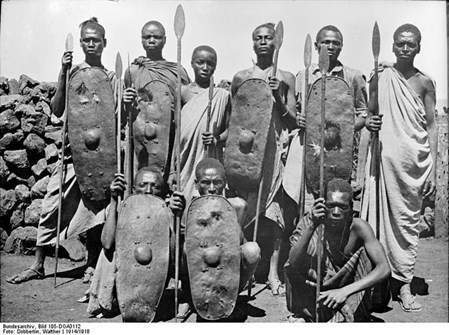
Shorthose moved out his column next morning, leaving a small escort to guard the baggage. He detoured through the bush to approach Tunduru along a ridge from the north-west and then split his force, one group giving covering fire whilst the other group deployed to attack. The South African machine gunners performed particularly well in laying down supporting fire. The attack group met the Germans as they were withdrawing and dispersed them. During the fighting 3208 Lieutenant Fadlmullah Effendi Kheiralla captured the enemy three-pounder British-manufactured naval Hotchkiss gun and later received an Imperial Distinguished Conduct Medal:
For conspicuous gallantry and devotion to duty. He led an attack and occupied an enemy gun position, where he found a gun with lighted fuse hanging from the muzzle. He-immediately took steps to safeguard his men, then went forward alone, at great risk, to extinguish the burning fuse. He has always set a fine example to his men.
This appears to have been the only Imperial Distinguished Conduct Medal awarded to a member of the King's African Rifles during the Great War, as other African officers and men were awarded the African Distinguished Conduct Medal.
1/4 KAR had now carried out its orders, cleared PEA of Germans, and was established at Tunduru. British Intelligence Agents with their own Ruga Ruga irregulars marched across and made contact from the Songea region; these Ruga Ruga were under the command of Major J.J. McCarthy DSO MC, Northern Rhodesia Police. By now a steady trickle of disillusioned Schutztruppe Askari deserters was appearing; these men had decided that the British were going to be the winners in the war that was devastating their country. It was hoped that soon elements of 1 KAR would approach from the north-west, and so Shorthose's men wrapped blue bands around their headdress for identification purposes. But a fast-moving and determined enemy was preparing to approach from the north, and before very long Shorthose and his Askari would be out on a limb, fighting for their lives.
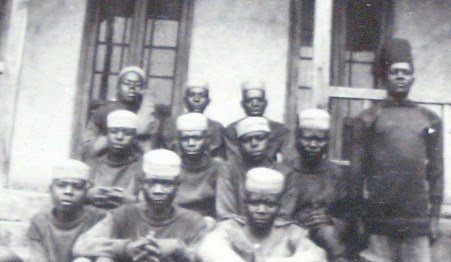
Operations around Tunduru and the Mohesi River
For the next ten weeks Shorthose Column garrisoned, patrolled and skirmished in the Tunduru region against enemy forces led by Lieutenant Commander Jantzen. Intense patrolling took place and re-supply convoys of porters arrived from Nyasaland bringing much-needed shorts, puttees and wireless spare parts as well as food. Local Ruga Ruga irregulars were enlisted and often placed under the command of European members of the Nyasaland Volunteer Reserve; prominent Volunteers supporting the column were 543 A Burnett & 634 T H Hicks who acted as supply buyers, Volunteer Hayter who led re-supply convoys, 472 J W Easterbrook (Intelligence Staff), 196 W G Manuel and J C Casson. In a contact on 10 September a 25-man patrol under Lieutenant N C Millman (South African Service Corps) discovered a German company camp and charged into it, routing the enemy who were there. For good work during this action 6892 Private Oyet Opia of No 3 Company received promotion.
The battalion Quartermaster, Lieutenant Edwin Ernest Wilson, who had been commissioned from the Army Service Corps in February 1917, earned a Military Cross at Nambalas on 18 September with the citation:
For conspicuous gallantry and devotion to duty. He was in charge of a convoy which was ambushed by the enemy. Under heavy close range fire he collected a few men and kept the enemy off until support came. By his courageous example and good leadership he forced the enemy to retire and saved the convoy.
Edwin Wilson had been riding his mule when he was ambushed, his mount was hit and he was unseated into long grass. On hearing the contact 1800 Sergeant Abdullah Bin Hassan brought 19 men forward and joined his officer in the fight. Abdullah Bin Hassan was later awarded a Military Medal.
In late September Shorthose split his column and sent a force of 300 men under Major E B B Hawkins with four machine guns to operate against Jantzen's troops along the Mohesi River where it crossed the Liwale road. Hawkins' Askari were in action against the 8th Schutzen Company on 24 September, losing four men killed and five wounded but driving back the enemy. Captain H J C Hammond and Lieutenant A J Green (South African Field Artillery) were particularly prominent in the action, as was Sergeant Sadallah Mahomed who held his Askari together whilst under very heavy machine gun and rifle fire. It was believed that now Captain Erich Muller had taken over from Jantzen as the local enemy commander.
Further contacts were made with the 13th Field Company from the Lindi area, reputed to be von Lettow's favourite troops. Intelligence Agent E R Seymour (East African Intelligence Department and previously Belfield's Scouts) patrolled the column area and, in mid-September west of Ngomano, he routed an enemy patrol. Egerton Rothesay Seymour later received a Military Cross:
For conspicuous gallantry and devotion to duty. He has repeatedly performed marked acts of courage and initiative, and he has on two occasions attacked and routed enemy patrols, though greatly outnumbered. Within the last two months he has himself accounted for sixteen of the enemy during various patrol encounters, and has burned large quantities of enemy supplies, his work being magnificent throughout.
Other Intelligence Agents supporting the column were Willcox, Florence and Sharpe. Scout Lewis (probably Volunteer 510 G A Lewins, formerly named Lewine) led several aggressive Ruga Ruga patrols, on one occasion routing an enemy party and killing a German. As well as patrolling, food purchase parties were constantly trekking through the bush buying surplus crops from village headmen with rolls of cloth sent up from Nyasaland for use as payment, and carrying the purchases back to the column locations to be converted into rations. During September the first three of eight Lewis light machine guns arrived for the battalion from Nyasaland. Trained Askari were now also carrying hand grenades that could be thrown or else projected from a rifle. The aircraft, now based north-east of Songea at Likuyu, and crewed by Lieutenants Blackburn and Steadman, regularly over-flew the operational area, dropping improvised bombs on enemy parties that were observed. Shorthose, based at Tunduru, used the 'Old Bee' to distribute orders around his various outposts. At the end of September the column's casualty figures since leaving Mtonia were: six men killed including one European; 14 men wounded including one European; three men drowned during a crossing of the Rovuma; seven men died of sickness; and three men were missing. Colonel Shorthose's force was now named Tunduru Column.
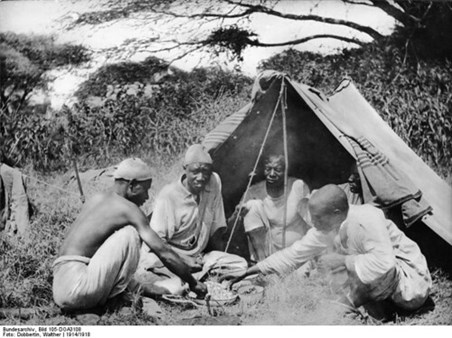
Local operations continued in October and enemy stragglers continued to come in; suitable ex-Schutztruppe Askari were enlisted directly into 1/4 KAR. On 14 November Volunteer Reverend Thomas Hicks of the Nyasaland Volunteer Reserve held a church service at Tunduru, and the older Askari were pleased to hear of the awards of the African General Service Medal to participants in the pre-war Turkana and Dodinga operations in northern Uganda. Three new European officers and 14 European NCOs joined the battalion, as did a South African Defence Force Topographical Section from Mtungwe commanded by Sergeant Quigley. Smallpox was detected amongst a few of the 2nd Line Porters. Shorthose recruited many local villagers into irregular Ruga Ruga units and used them to garrison outposts, thus ensuring a constant supply of locally-grown food.
On the following day Major Hawkins force was ordered to Abdullah Kwa Nanga, north-east of Tunduru, to attack any isolated Schutztruppe parties that he came across. To the south-east the largest and fiercest battle of the campaign was underway at Mahiwa, whilst to the south of Tunduru Column Intelligence Scouts and Ruga Ruga irregulars under Captain Lionel Cohen MC (East African Intelligence Department and South African Defence Force) were clearing the enemy from the western stretch of the Rovuma River.
Hawkins advanced to occupy Liwale on 29 November where he captured Captain Braunschweig and eight enemy Askari from the 14th Field Company. Soon Hawkins linked up with a Belgian Congolese battalion and an attached cyclist platoon that had been landed on the Indian Ocean coast at Kilwa. Shortly afterwards the German Captain Thiesen and eight Askari were also captured at Liwale.
On the final day of October the five remaining Lewis Guns arrived at Tunduru and General Northey's Headquarters ordered that Hawkins should hand over Liwale to the Belgian Commandant Herion, and return to Abdullah Kwa Nanga to deny the food in that area to Tafel's troops who were swiftly approaching.
The encounter battle at Abdullah Kwa Nanga
November started for 1/4 KAR with an excellent patrol for which 4167 Sergeant Abdullah Wakulira of No 4 Company was awarded an African Distinguished Conduct Medal:
For the special determination, initiative and courage he displayed at Lihato, on 2nd November 1917, when together with 10 Askaris he surprised and captured two German whites and two Askaris, obtaining valuable information. He crept up and captured a sentry, after which he surrounded the enemy camp and killed the two Europeans, in spite of their efforts and resistance, he himself suffering no casualties. He has throughout the war set a fine example to his men.
5563 Private Fabya Zake, also of No 4 Company, was awarded the Military Medal for his part in this action which involved, along with two other Askari, tracking an enemy European for an hour before capturing him.
Abdullah Wakulira killed a man named Rossner and mortally wounded another named Rucke; one of the captured Germans was named Knoller. Also captured were six Askari, seven loads of ammunition and 14 loads of food. Knoller stated that his group was reconnoitring water holes and staging posts for an enemy force under Captain Theodor Tafel that was moving down from the north.
Theodor Tafel had been commanding an enemy group at the western end of the GEA Central Railway, near Lake Tanganyika, and then on the Mahenge Plateau. He had fought actions with the Belgian Congolese troops that had crossed the lake, but his men considered themselves to be so far unbeaten. Now Tafel and the 1400 men of his Westtruppen were marching swiftly in three columns to link up with von Lettow's main force west of Lindi, in the south-east of GEA.
Trained men from the 5th South African Infantry were sent to the Column to serve as Lewis Gunners. A 1/4 KAR sentry, 5207 Private Asmani Bin Juma, was found asleep at his post and sentenced to Field Punishment No 2 (wearing shackles for 2 hours out of every 24) for eight months. No 2 Company fired a preliminary musketry course. By now motor vehicles were being used to drive eastwards through Liwale towards Kilwa to collect radio spares and other important items. Sadly, on 12 November, Sergeant Alfred George E Shepard (3rd Royal Berkshire Regiment, and recorded in the 1/4 KAR War Diary as being a Temporary Lieutenant in No 1 Company) was killed by an elephant when on patrol on Rondo Mountain.
Captain T Slattery MC, DCM, Column Intelligence Officer, returned to Nyasaland for duties at the 1 KAR Depot, Zomba. Captain A J Ballantine (South African Medical Corps) arrived to be Shorthose's Medical Officer bringing with him three Medical Orderlies and 17 Stretcher Bearers. Captain G A Williams (Royal Army Medical Corps) joined Hawkins as his Medical Officer; soon all these medical personnel would be swamped with work.
Hawkins' troops, 360 Askari with four machine guns and four Lewis Guns, moved to the Jumbe Faume area near Abdullah Kwa Nanga to patrol, and began to make lively contacts with advanced patrols from Tafel's force. Hawkins was ordered to deliver an attack when an enemy main body could be identified. "Hawkins will strike at any enemy that come within reach and delay them as long as possible pending arrival of Shorthose and Murray" were the words sent by General Northey's Headquarters. Northey was now depending on Shorthose's column to stop the German withdrawal that was moving across the Mahenge Plateau.
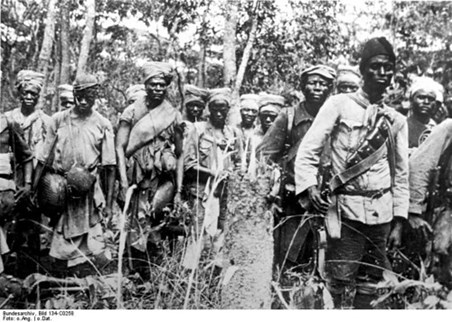
Shorthose was ordered to march to join forces with Hawkins and so he moved out from Tunduru on 13 November with 192 Askari, two machine guns and two Lewis Guns; the two machine guns of the 5th South African Infantry also marched with him. A supply convoy of 1,000 porters accompanied Shorthose. No 2 Company with two machine guns stayed as the garrison at Tunduru. Meanwhile a Rhodesian column under Lieutenant Colonel R E Murray DSO (British South African Police) was marching to Hawkins' assistance from the north-west, but this column was just too far away to intervene effectively.
On 16 November at 0630 hours Shorthose approached Jumbo Faume and heard firing from Hawkins' position. He received a note delivered by two of Hawkins' Askari requesting that he march to Hawkins assistance immediately. Shorthose complied and marched towards the sound of the guns, but this unfortunately led him across the path of the advance of an enemy column commanded by Captain Ernst Otto, a formidable and professional opponent. After defending the Rufiji crossings Otto had moved west with his five companies to join Tafel's Westtruppen on the push south to join with von Lettow. Shorthose was also encumbered by having to protect 1,000 porters, and his fighting troops were deployed in a column of march and not for an advance to contact; thus he had no defence in depth to counter Otto's advance.
Shorthose's advance guard commander was Lieutenant G E Hawkins (Royal Berkshire Regiment) of No 2 Company with No 8 Platoon and two Lewis guns. Geoffrey Eden Hawkins was soon involved in a fight for which he was awarded the Military Cross:
For conspicuous gallantry and devotion to duty. Owing to his courageous example he rendered invaluable assistance in beating off a charge made by greatly superior forces of the enemy, upon whom heavy casualties were inflicted. Having withdrawn his men in good order, he finally carried a wounded officer back to safety under very heavy fire. His cool bearing and utter fearlessness were most praiseworthy.
The two 5th South African Infantry machine guns under Lieutenant Clarke and one KAR machine gun commanded by Sergeant G H Knowlton advanced on the left of the path and came into action. Then German bugles sounded from both flanks and attacking enemy Askari erupted from the bush. As the Advance Guard fell back it was incorporated into three sides of a square that soon shrank because Shorthose had no immediate reserves to add to it. All three machine guns were over-run and captured, 105832 Sergeant James Henry Knowlton (Hertfordshire Yeomanry) was killed on his gun, and Lieutenant M Clarke and all his South Africans with the exception of one man were shot down and killed or wounded on their two guns.
The fighting was now hand-to-hand and Lieutenant Geoffrey Simpson (East African Mounted Rifles) of No 2 Company earned a Military Cross:
For conspicuous gallantry and devotion to duty. When with a small party, which was attacked by superior numbers of the enemy, he continued fighting, leading and encouraging his men, though he had been twice wounded. His courage and dogged determination were worthy of the highest praise, and proved a splendid example to the men under him.
Geoffrey Simpson had been wounded in the face and hand.
Captain Joseph Edgar Hugo Lambert (East African Mounted Rifles) also gained a Military Cross, 13932 Lewis Gun Sergeant A J Hoffman, No 2 Company, (5th South African Infantry) received a Military Medal; CM 281 Lewis Gun Sergeant F E Walker, also of No 2 Company, (South African Motor Cycle Corps) was wounded.
1771 Lieutenant Miyoiyo DCM won a Bar to his African Distinguished Conduct Medal:
For conspicuous gallantry at Abdullah Kwa Nanga on 16th November 1917.By his brave example of courage and endurance, he kept his men together under most difficult circumstances when attacked in the bush by superior numbers, himself killing many of the enemy. He has constantly shown great courage and initiative.
4024 Sergeant Wameyu of No 2 Company, 4001 Sergeant Suliman Jabara, Machine Gun Half Company, and Machine Gun Porter Amiri Mukassa were each awarded the Military Medal.
The Column Adjutant, Major Eric Aylmer Goldney Snell, was killed early in the fight; 14033 Sergeant J C S Frylinck (5th South African Infantry) was also killed. The enemy Askari then fired into the bunched-up 1,000 unarmed porters, and those porters that were not hit dropped their loads and scattered into the bush as fast as they could run. Shorthose now ordered a withdrawal and he regrouped on a ridge to make stretchers for the wounded before marching back to Tunduru. He was met by his Medical Officer Captain Ballantyne who had marched for 35 kilometres through the night from Tunduru when news of the action reached there.
Captain E L Lindsay of No 2 Company became cut off with 16 men and the wounded Lieutenant Simpson. Lewis Gun Sergeant Walker was with this group and, when he was wounded, Lindsay got him and his gun safely away, firing the gun himself as they withdrew.
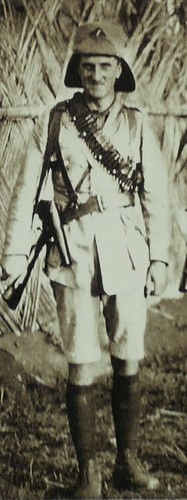
Lindsay fought his way out of the battlefield, collecting more scattered KAR Askari as he went and he was carrying Simpson on a makeshift stretcher when he bumped into the German baggage column. Here savage hand-to-hand fighting took place during which six Germans and several Askari were killed or left for dead.
After bivouacking for two nights in the bush Lindsay's group, which had been regarded as all dead, rejoined Shorthose. Eric Lawrence Lindsay (East African Mounted Rifles) was awarded a Distinguished Service Order:
For conspicuous gallantry and devotion to duty. With forty men he succeeded in repelling an enemy attack made with greatly superior forces and in inflicting severe casualties on them. Later, when surrounded, he extricated his party with the greatest skill and determination, himself accounting for twelve of the enemy, and succeeded later in joining up with his main body. His conduct in action has always been characterised by courage and resource.
Having successfully and violently fought through Shorthose's column Otto's men moved quickly off the battlefield towards the south-east.
The fight in the Ngurumahiga Valley
At 1430 hours on 15th November Major Hawkins advanced his men from Jumbo Faume and moved to attack an enemy force of around two field companies that was observed in Ntenderes Village in the Ngurumahiga Valley. After deploying cross country through thick bush throughout the night Hawkins came into action at 0540 hours near the Liwale road and the Ngurumahiga River. For two hours the KAR Askari held their own against a column led by Captain Werner Schonfeld, but they were soon up against Tafel's column as well, which surrounded them. After at first pretending to be Belgian troops the German Askari mounted attacks from both flanks onto the British position, as usual sounding their bugles to signal orders.
The fighting now became very close and fierce and Hawkins ordered a tactical withdrawal to a perimeter position, during this move C M 24 Lewis Gun Sergeant B L Hollander MM, No 1 Company, was killed in action on his gun. GM 118 Lewis Gun Sergeant D N Olive, No 1 Company, (South African Motor Cycle Corps) retrieved Hollander's gun and was later awarded a Distinguished Conduct Medal:
For conspicuous gallantry and devotion to duty. He fired his machine gun with great effect under a very heavy fire, showing an utter disregard for danger, and was largely instrumental in repelling the hostile attacks. Later, he took charge of two guns, and firing them alternatively, did great execution in the enemy ranks. He finally withdrew his teams in good order, and saved his guns from imminent danger of being captured. His courage, coolness and resource cannot be too highly praised.
Close and fierce fighting continued and 325054 Machine Gun Sergeant Ephraim William Sadler, Machine Gun Half Company, (Essex Regiment) was killed and 350949 Sergeant R J Smith, No 1 Company, (7th Battalion The London Regiment) was wounded. Two immediate awards of the Military Cross were made. The first to the wounded Lieutenant Thomas Jarvis Murray (East African Mounted Rifles) of No 1 Company:
For conspicuous gallantry and devotion to duty. He helped to carry a wounded officer for 200 yards under a very heavy fire, and assisted in repelling attacks made by superior forces of the enemy. At all times under the most trying circumstances he has shown marked courage, resource and endurance.
The second Military Cross went to Lieutenant John Frederick Buller, (East African Ordnance Department), Machine Gun Half Company:
For conspicuous gallantry and devotion to duty. He helped to carry a wounded officer for 200 yards under a very heavy fire, and assisted in repelling attacks made by superior forces of the enemy. Later, when all his machine-gun crews had become casualties, he himself carried one of his guns back to safety. At all times under the most trying circumstances he has displayed a courage and an initiative worthy of the highest praise.
4564 Corporal Lolenti Musoke was awarded the Military Medal.
Captain A H Gee (Uganda Volunteer Reserve), who had been on a detached mission with two platoons and two Lewis Guns, arrived at the perimeter at 0820 hours and drove the Germans back 750 metres. However enemy pressure led to Gee being ordered inside the perimeter. Tafel's men kept attacking until after noon, when they broke off to resume their march south-eastwards carrying four captured machine guns, but their rearguard was attacked by the Belgian 2/IX Battalion under Commandant Berns and the cyclist platoon under Lieutenant Delmotte. Delmotte's men arrived first on the scene and immediately engaged the enemy. The German 10th Field Hospital was seized and some of the captured British wounded who were being treated there were released.
Captain Douglas Alexis Hunt, (East African Mounted Rifles), was extremely prominent in the fighting and was mortally wounded. He received an immediate Distinguished Service Order:
For conspicuous gallantry and devotion to duty. When in command of the firing line, through his personal courage and example he was largely instrumental in repelling several enemy counter-attacks, which were launched against him by very superior forces. On these occasions of danger and difficulty his courage, coolness and determination were of the highest order, only equalled by his courageous conduct on all other previous occasions.
Douglas Hunt was over-run and captured by the Germans after the two porters carrying him had been killed; he was released later when the Belgians captured the German field hospital. He died 15 days after the battle.
Major Edward Brian Barkley Hawkins had carried out his orders to the letter. He also received an immediate award of the Distinguished Service Order:
For conspicuous gallantry and devotion to duty. Boldly attacking a superior enemy force, he inflicted severe casualties on them, thus diverting them from their objective, and being instrumental in causing their subsequent surrender. He has at all times shown the greatest courage and initiative, and has afforded a most inspiring example to the troops under him.
The aftermath
Shorthose's column had lost seven Europeans killed or dead from wounds and at least nine others wounded. Around 50 1/4 KAR Askari were dead, wounded or missing. The 1,000 supply convoy porters were casualties or else were moving swiftly back to Nyasaland unencumbered by loads that were now irretrievably scattered in the bush. German casualties were believed to be at least eight Europeans killed and three wounded, plus an unknown number of Askari casualties. Tafel had also lost his 10th Field Hospital with staff and patients when the Belgians captured it.
General Northey sent Shorthose this message:
"Very sorry hear about Snell and other casualties. Loss of MG and convoy is a pity, but I think you did very well, and if everyone out here would go in and fight like you and Hawkins have just done we should soon finish campaign." 1/4 KAR moved to Songea, then to Mbamba Bay on Lake Nyasa and finally to Blantyre, Nyasaland where it re-fitted and reorganised, and prepared itself for operations during 1918
Two Askari of No 2 Company who had displayed conspicuous gallantry at Abdullah Kwa Nanga, 1840 Corporal Musa Bin Abdulla and 1897 Lance Corporal Okong, were both promoted by one rank. In the 1918 New Year's Honours List, Lieutenant Colonel William John Townsend Shorthose received the Distinguished Service Order.
The following men who were members of the Column or who provided support were Mentioned in Despatches:
Captain A J Ballantine (South African Medical Corps);
Captain G A Williams (Royal Army Medical Corps);
Honorary Major J C Casson (Nyasaland Volunteer Reserve & Political Department);
Sergeant D McPherson (Nyasaland Volunteer Reserve);
Volunteer G A Lewins (Nyasaland Volunteer Reserve);
Volunteer G E Thompson (Nyasaland Volunteer Reserve);
Captain A H Gee (Uganda Volunteer Reserve & 1/4 KAR);
Lieutenant F H J Hillier (Kaffrarian Rifles & 1/4 KAR);
Captain R W Hodson (1/4 KAR);
Lieutenant F B McMagh (South African Signals & 1/4 KAR);
Lieutenant M C Millman (South African Service Corps & 1/4 KAR);
Lieutenant T J Murray MC (East African Mounted Rifles & 1/4 KAR);
Z/1748 Sergeant F V Frost (6th Bn The Rifle Brigade & 1/4 KAR);
350949 Sergeant A J Smith (7th Bn The London Regiment & 1/4 KAR);
CM281 Sergeant F E Walker (South African Motor Cycle Corps & 1/4 KAR);
3442 Corporal Bashir Khamsur (1/4 KAR);
3860 Corporal Doka Bakhit (1/4 KAR);
2710 Company Sergeant Major Farajalla Murjan (1/4 KAR);
4014 Company Sergeant Major Mikairi Muganda (1/4 KAR);
1840 Sergeant Musa Bin Abdulla (1/4 KAR);
1897 Private Okong (1/4 KAR);
1503 Company Sergeant Major Sanduka (1/4 KAR).
Murray's Rhodesian Column arrived at Tunduru on 25 November to take over security responsibilities in the region. Further south, Theodor Tafel failed to link up with von Lettow who was already in Portuguese East Africa. Tafel surrendered his Westtruppen on the northern bank of the Rovuma on 28 November. He had crossed the river but failed to find traces of von Lettow's now slimmed-down Schutztruppe. Concerned about his shortage of supplies and indiscipline within the Westtruppen ranks, Tafel re-traced his steps back to the now-occupied German East Africa and to captivity.
But Ernst Otto stayed in the field to fight. Tafel had authorised him to stay on the south bank of the Rovuma with a patrol of 14 Germans and 23 Askari. Otto met up with the equally determined Captain Karl Goring and they raided Portuguese posts for supplies until they reached their commander's location four weeks later.
End note
The actions at Abdullah Kwa Nanga and Ngurumahiga are not widely known or well recorded. This may be because 1/4 KAR was operating out of Nyasaland as part of General Sir Edward Northey's NORFORCE which itself is little-known and poorly documented. Also the 4th King's African Rifles is not a well-known KAR regiment as a historical record was never published. However the regimental War Diaries and record of Despatches are reasonably intact in the British National Archives.
Undoubtedly 1/4 KAR's courageous and determined fight, bravely supported by Maxim and Lewis gunners from the 5th South African Infantry, was instrumental in the demoralisation and subsequent surrender of Tafel's Westtruppen, and Shorthose's column deserves more acknowledgement for this achievement and the sacrifices that were made.
An interesting feature of the awards detailed above is the number of officers who first enlisted in the ranks of the East African Mounted Rifles, an all-white unit raised in British East Africa (BEA - now Kenya). On being commissioned these men transferred to the KAR. Both Nyasaland and Uganda were ahead of BEA in having pre-war rifle clubs that acted as reserve training units for European Volunteers. Both those Protectorates also used their European Volunteers as a leadership resource to provide officers and Senior NCOs for African units.
British East Africa chose to be different - it did not have pre-war military-affiliated Rifle Clubs or European Volunteers, and the white settler community consistently resisted taxation for military expenditure. The Governor himself was remarkably unenthusiastic, to put it mildly, about involvement in the Great War, and many settlers agreed with him.
Fortunately some courageous and patriotic men did not agree with this pacifism, and they enlisted and were posted into all-white units such as the East African Mounted Rifles and the East African Regiment. But these units were ill-disciplined and poorly trained, and soon many of the white soldiers obtained their Governor's permission to return to their farms or businesses. Those that remained in service were BEA's pool of potential military leaders, but they wasted away their health and utility by serving as junior ranks instead of being trained and developed to command KAR machine gun detachments, rifle platoons and companies.
When General Smuts ceased to be theatre commander and his illusions about swiftly and decisively defeating the Schutztruppe were discarded as being unrealistic, the King's African Rifles was rapidly expanded. Then the massive shortage of suitable European leaders who knew and could communicate with black Africans was keenly felt, and large drafts of "green" officers and NCOs were shipped out from England. Many of these men subsequently did very well as junior leaders in KAR battalions as citations for awards prove, but the in-theatre training of these new leaders both in bush warfare and in language skills was not either quick or easy.
The awards shown above to ex-members of the East African Mounted Rifles and other units are splendid demonstrations of the leadership potential existing in pre-war British East Africa, and they show how useful the European-only units could have been had they been utilised as leadership cadres in August 1914. But it took over 18 months before the KAR became Imperial Troops managed from London for the duration of the war, and until that happened direction of the KAR regiments and locally-recruited units was in the hands of the Protectorate Governors who shrank from "arming too many natives". Meanwhile, across the border in German East Africa, Colonel Paul von Lettow-Vorbeck rapidly expanded his African Field Companies to the extent that his resources allowed, and those resources were massively boosted by the arrival of two blockade-running supply ships that evaded the Royal Navy.
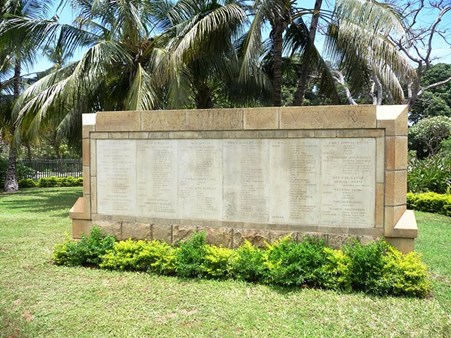
The British dead from the Abdullah Kwa Nanga and Ngurumahiga actions are commemorated in the Dar Es Salaam Commonwealth War Graves Commission War Cemetery, Tanzania or on the British and Indian Memorial in that cemetery.
Article and images submitted by Harry Fecit
Related articles on the WFA's website:
The Advance Beyond Kilimanjaro German East Africa (now Tanzania), March 1916
The Battle for Latema-Reata Nek, British East Africa, 11 - 12 March 1916
Indian Volunteers in the Great War East African Campaign
The King's African Rifles at Kibata, German East Africa December 1916 to January 1917
Fighting for the Rufiji Crossing
Medo and Mbalama Hill, Portuguese East Africa, 12 - 24 April 1918
Sources:
- 1/4 KAR War Diary and Despatches (WO 158/466).
- Sport and Adventure in Africa by Captain W.T. Shorthose DSO.
- The King's African Rifles by Lieutenant Colonel H. Moyse-Bartlett MBE, MA, PhD.
- Uganda Volunteers And The War (Anonymous).
- Notes by Captain Thomas Slattery MC, DCM (CAB 45/66).
- My Reminiscences of East Africa by General von Lettow-Vorbeck.
- Tip & Run. The Untold Tragedy of the Great War in Africa by Edward Paice.
- So Many Loves by Leo Walmsley MC.
- Shells & Bright Stones - A Biography of Leo Walmsley by Nona Stead.
- Cinderella's Soldiers - The Nyasaland Volunteer Reserve by Peter Charlton.
- Despatch from Lieutenant General Sir J.L. van Deventer KCB dated 21st January 1918 (London Gazette Number 30611 dated 5 April 1918).
- The African DCM compiled by John Arnold.
- East African General Routine Orders (WO123/288).
- British Intelligence Supplement No 7 dated October 1916.
- The Award of the Military Medal to African Soldiers of The West African Frontier Force & The King's African Rifles from 1916 to 1919 by John Arnold with William Spencer MA & Keith Steward FRGS.
- Recipients of the Distinguished Conduct Medal 1914-1920 compiled by R.W. Walker.
- Honour The Officers. Honours and Awards to British, Dominion and Colonial Officers during the First World War by Michael Maton.
- The London Gazette and Medal Index Cards.





